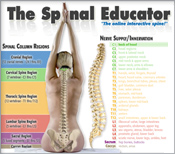|
Research shows that when treated with chiropractic adjustments, sciatica has an 8-9% greater rate of recovery than if patients were to use therapy or standard medical care.  The largest nerves of the body. The largest nerves of the body.Pain is caused when the sciatic nerve roots are irritated, scraped, twisted, stretched or pinched as they exit the spine. Causes of the impairment may be chemical, physical or the emotional stress of everyday living. A full-blown sciatic flare-up can involve the entire sciatic nerve path resulting in symptoms of lower back pain, burning, cramping or numbness that radiates into the thighs, legs, ankles, feet and toes. Pain may also be limited to various points along the nerve, such as the buttocks, knee area and calf.
THE CHIROPRACTIC LIFESTYLE
Chiropractors are experts in the care of the bones, nerves, muscles and connective tissues that make up about 60% of your body. All of the joints in your body are part of this musculo-skeletal system and its optimal function is necessary for overall good health. Ask your Doctor of Chiropractic for more information about a care program that may include specific spinal adjustments, exercise recommendations, nutritional advice or other conservative methods of care based on your health history, age, current condition and lifestyle. REFERENCES:
Gray, H., 1827-1861, Grays Anatomy, Williams P., Worwick, R., Editors, 37th edition, Churchill Livingstone, 1989, Reprinted 1993. Kirkaldy-Willis, W., M.D., Managing Low Back Pain, 3rd edition, Churchill Livingstone, 1993. Kur, F., Loh, C., Treatment of Lumbar Intervertebral Disc Protrusions by Manipulation, Clinical Orthopedics, 215-47, 1987. Manelfe, C., M.D., Imaging of the Spine and Spinal Cord, Raven Press, 1992. Memmler, R., M.D., Structure and Function of the Human Body, 5th edition, J.B. Lippincott Company, 1992. Moore, K., The Developing Human: Clinically Oriented Embryology, 3rd edition, W.B. Saunders Company, 1982. Nwuga, VCB: Relative Therapeutic Efficacy of Vertebral Manipulation and Conventional Treatment in Back Pain Management, AM. Phys. Med., 61:273, 1982. Shekelle, P.G., Adams A.H., Chassin, M.R, Hurwitz, E.L., and Brook, R.H. Spinal Manipulation for Low Back Pain. Ann Intern Med 1992; 117:590-8. Rothman, M.D. Simone, M.D., The Spine, 3rd edition, W.B. Saunders, 1992. White, A.A., M.D. and Panjabi, M.M., Ph.D., Clinical Biomechanics of the Spine, 2nd edition, J.B. Lippincott Company, 1990. ©2002 Back Talk Systems, Inc. (800) 937-3113 (303) 277-9990 www.backtalksystems.com |
1750 West Broadway Street, Suite 108 | Oviedo, Florida 32765
Tel: (407) 977-7233 | Fax: (407) 359-6822
Office Hours - call for appointment times
Oviedo Florida Chiropractor Chiropractors Chiropractic Doctors
Copyright 2024 - ChiroPlanet.com
Privacy Notice - Admin

